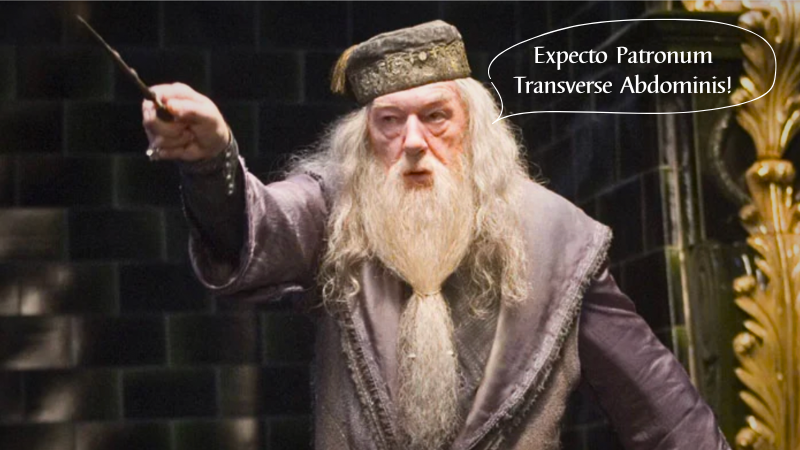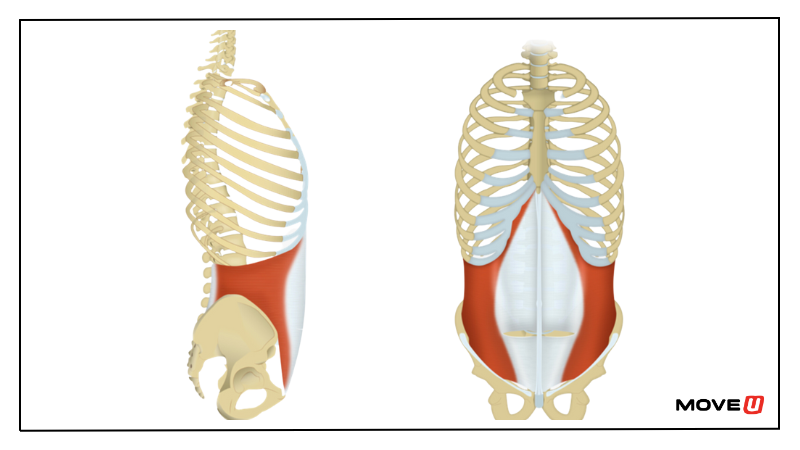
5 BEST EXERCISES FOR YOUR TRANSVERSE ABS
Your body is AWESOME. It has a natural “corset like” muscle that wraps around your trunk. It’s literally built into your body, so if you’ve got a waist trainer or other such nonsense, this is your sign to throw that out.
What Is the Transverse Abdominis?

The transverse abdominis (TA for short) may sound like something you’d hear in a Harry Potter movie, but it’s a major abdominal muscle and critical for the stability of your spine - you should get acquainted with it!
The TA is a sheet of muscle that extends from your ribs to your pelvis and wraps around your trunk from front to back. As the deepest layer of your abdominal muscles, it acts as a built in core stabilizer.
You know those back braces used by contractors and construction workers? It’s like that… but on the inside!
WHAT DOES THE TRANSVERSE ABDOMINIS DO?

Along with your other abdominal muscles, the transverse abdominis also:
- Maintains abdominal wall tension to protect and support your abdominal organs.
- Manages intra-abdominal pressure which is helpful for everything from weightlifting to birthing babies to coughing and pooping.
- Supports the lumbar spine and pelvis during movement.
SIGNS OF A WEAK CORE
This is about more than visual aesthetics, ya’ll. Weak core muscles can results in:
- Poor posture.
- Increased fatigue.
- Lower back pain.
- Increase in muscle injuries.
- Abdominal hernias.
Strengthening your core muscles is a must for reducing or eliminating back pain, preventing injuries, and living with an improved quality of life that comes from having solid posture.
STRENGTHEN YOUR TRANSVERSE ABDOMINIS
These exercises and those that follow target your transverse abdominis muscle with maximum core engagement. As a general rule, three rounds of 8-10 reps is a good place to start.
Core Tip: When doing any core exercise, you want to avoid ‘doming’. This is when the front of your abdominal wall bulges outward. No, we’re not talking about skin and fat, but the actual muscle.
Doming occurs when your core isn’t properly braced or you’re going for more than your current strength level allows. This first exercise will help you tap into what it feels like to brace your core.
SNAP TECHNIQUE WITH FULL EXHALE

The “Snap” is an abdominal wall contraction. Pairing this with the Full Exhale ensures you really learn what it feels like to contract your transverse abdominis. Once you’ve got a handle on this contraction with the exhale, work to keep it on your inhale as well.
- Step 1: Stand upright with good posture. Maintain that as you inhale into your lower rib cage and then brace your abs as if someone is about to punch you in the stomach. You should feel your pelvic floor draw up and in as well here.
- Step 2: Now exhale slowly and completely. Keep that upright posture and as you squeeze every last bit of breath out and feel your abdominals, side obliques, and back contracting.
- Step 3: Release and inhale again.
Tip: To check to see if you are doing the snap technique right, press your fingers into your abs to feel the texture of your core. When you "snap” you should feel your core muscles harden underneath whatever fat and skin is present.
DEAD BUG

The deadbug works your abdominal muscles as well as your hip flexors. Some people notice clicking or snapping sounds in their hips when doing these kinds of movements. If this is you, learn why and what you can do about it.
- Step 1: Lie on your back with your arms reaching straight up and your legs bent to 90 degrees. Lift your head off the floor slightly. If this is too difficult at first, you can rest your head on the floor or a pillow.
- Step 2: Exhale as you extend your right leg and left arm away from your body. The hardest version of this will be to have both arm and leg straight and hovering above the floor. You can modify this by bending the knee and tapping your heel on the floor as shown in the image above. Keep your core engaged and low back flattened to the floor. If your low back arches, reduce the range of motion until you can keep it on the ground.
- Step 3: Inhale as you return to the original position and exhale as you repeat on the other side. This is one rep.
PLANK

Done correctly, these are very difficult as they are a full body exercise. Remember that form trumps reps and duration every time.
- Step 1: Set up on your hands and knees. Your wrists should be stacked under your shoulders the entire time. Reach your head away from your body to create some length in your spine and keep your gaze between your hands.
- Step 2: Spread your fingers and press your hands and shoulders toward the floor.
- Step 3: Step your feet back to bring your body into a plank position, drawing your entire abdominal wall up towards your spine. Imagine your back is a tabletop and try to create as level a surface as you can from head to tailbone.
- Step 4: Hold for as long as you can (30 seconds to two minutes). Avoid letting your hips drop or your low back to arch.
SUPERMAN

This exercise is designed to focus on the extension muscles of the posterior chain, but by keeping your abs engaged and pelvis tucked, you target the deep abdominal muscles as well.
- Step 1: Lie face down on the floor with your legs extended and your arms over your head.
- Step 2: Tuck your pelvis and engage your abs. This should already feel like a very active position.
- Step 3: Exhale as you slowly raise your legs and upper body off the ground, keeping your head neutral.
- Step 4: Hold as you exhale all the breath out, inhale as you slowly return to the floor. Repeat.
LEG RAISES

Another abdominal + hip flexor double play!
- Step 1: Lie down on your back and engage your core.
- Step 2: Press your lower back into the ground and lift your straightened leg up to 90 degrees. If your hamstrings are tight, bend the knee slightly.
- Step 3: Maintain your core engagement and slowly lower your leg as you bring the opposite leg up. Continue alternating the legs like scissors as you rep it out.
JOIN US! THERE’S MORE WHERE THAT CAME FROM.

A strong core is absolutely essential for keeping your spine stable and healthy, and the transverse abdominis is one of the powerhouse muscles that you can’t live without.
Looking for more exercises to help you learn how to properly engage all of your core muscles? Start with our Back & Core program! We have programs for every area of your body in the MoveU membership.
